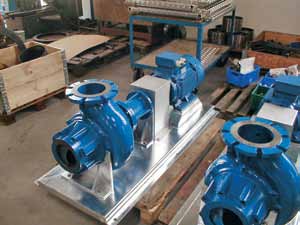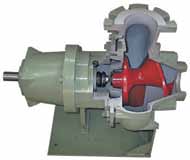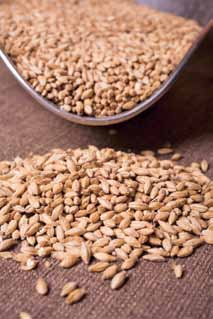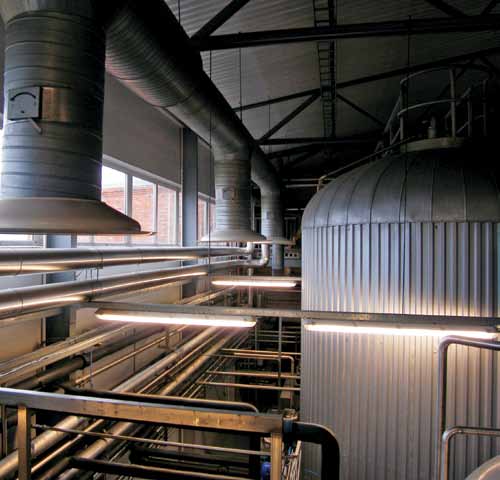New pump application helps create high-efficiency brewing process.
Although it is a process that is prone to problems, the need to pump malt is central to the brewing industry. However, a project in Denmark has shown that many of the traditional difficulties can be avoided by choosing the correct type of pump for the application.
Moving Malt Mash
In its basic form, the brewing process involves bringing together water, a starch source—such as malted barley—and a flavoring—such as hops. The malted barley is usually crushed and mixed with water to create a thick, sugary and solids-heavy mash, which is then taken to the next stage of the brewing process.
It was this last stage that caused major difficulties for one of the leading providers of malt to the Danish brewing industry.
Problem
The brewing company had been using a semi-open vortex impeller unit to pump the malt mash. These are regularly used to transport liquids through piping, with the liquid entering the pump impeller along or near its rotating axis and then being driven radially outward into a diffuser before it leaves the pump at a higher speed than it entered. However, in this instance, problems had arisen due to the high solids content of the malt mash.
Whenever the pump was turned off—even for a little as one hour—moisture would begin to escape from the malt, leaving behind an increasingly less liquid mash.
To begin operation, a centrifugal pump must be primed with the fluid to be pumped. As the malt in this case became increasingly dry, it became more and more resistant to being moved.
This in turn made the pump increasingly difficult to restart. In many cases, the only option was to open and clean the pump, and sometimes the adjacent piping too, before the pump could be restarted. This process lead to additional downtime and extra costs.
In addition, the customer ideally wanted to use less water when creating the malt mash because this would lead to a better end product. However, reducing the water content was not an option with the existing pumping arrangement because it was likely to lead to a number of other problems that are common to centrifugal pumps—such as reducing the flow of pumped liquid, which in turn can cause overheating of the pump.
Increasing the proportion of solids content by reducing the volume of water in the malt mash was also likely to increase the level of wear and tear to the impeller and could even have helped induce corrosion inside the pump. Clearly, a new pumping solution was needed.

The high efficiency screw channel pump installed in the brewery.

A cutaway of the high-efficiency screw channel pump
Requirements
The new solution had to satisfy many criteria. The malt mash was an especially difficult liquid to pump. However, it needed to be pumped at flow rates of 18 to 19 cubic liters per hour, which meant that a powerful pump was required.
Consistent performance was also necessary so that no cumulative build-up or congealing could occur inside the system.
In addition to these specifications, the malt mash also had to be pumped smoothly so that its consistency remained undamaged.
Reliability and extremely high levels of hygiene and leak-free performance were essential requirements as well. To add to the demands of the chosen solution, extended intervals between scheduled maintenance were also vital to minimize expensive downtime.
Potential Solutions
A number of potential solutions were available. One was a simple, gravity-operated pump coupled with an inlet valve—which was rejected due to the likelihood of blockages caused by the solids content.
Another was a peristaltic pump that operates on the positive displacement principle, but the large percentage of solids present in the malt mash could again lead to blockages, caused by the rotor repeatedly opening and closing the flexible tubing used in this type pump.
Any blockage problems could have caused a recurrence of the drying out and thickening process, meaning that a peristaltic pump was not ideally suited to this application.
A progressive cavity pump offered another possible option.The combination of a rotor and stator generates a positive displacement action by creating a series of small, fixed-shape cavities within the pump.
As the rotor turns, these cavities fill with the pumped medium before moving along the line of the pump and taking the liquid with them. The relatively gentle action of a progressive cavity pump would certainly be suited to the malt application because it applies low levels of shearing to the pumped fluid and minimizes the likelihood of damage.
However, the new pump was required to sit in the relatively restricted floor area occupied by its predecessor.
The size of progressive cavity pump needed to provide the required power and flow rates would occupy too large an area, and this ruled out this type pump as a solution.

Malt used at the brewery
The Answer
Eventually, the decision was made to perform a trial using a high efficiency screw channel pump. Featuring a corkscrew-profile impeller fitted inside a cone-shaped casing, this pump is ideal for media that contain long fibers, sludges and slurries. It is often found in use on applications involving viscous or high-solid content fluids.
Although pumping liquids of this nature by other methods can often lead to considerable energy consumption and high maintenance costs, this was not the case with the screw channel pump. The open-channel design of the impeller and its corkscrew motion create a positive displacement action, literally pushing the malt mash away. Combined with the centrifugal forces involved, this generates a powerful yet gentle force.
Compared to the original centrifugal pumps, the screw channel pump replacement allows the liquid to move axially and without turbulence, which helps prevent excess foaming or damage to the malt grains. It is also able to maintain its flow rates even if the viscosity of the malt mash increases.
The solid content of the mash also proved to be no problem for this pump. On average, this type unit can reliably handle up to 13 percent solids because the cone shape helps ensure blockage-free operation.
This is the reason that this type pump is often specified to handle demanding duties involving the typically thick sludges and slurries found in food, beverage, water and waste applications. Many different models are available that can offer a wide variety of features such as resistance to abrasion, corrosion and cavitation.

Beer tanks at the brewery
Results
For the malt mash application, the screw channel pump has performed flawlessly. During periods of downtime, the pump has dramatically reduced the amount of moisture loss from the malt mash. The mash has remained far more fluid and has presented no resistance when the pump is restarted.
The powerful yet gentle performance of the pump and its ability to help retain moisture in the mash has also allowed the brewing company to reduce the volume of water required to create the mash without adversely affecting the pump's performance.
The power created by the pump means that it also uses less energy than its predecessor, but the malt is still being handled gently and without the risk of damage.
Even when operating at higher flow rates the relatively low energy consumption of the high-efficiency screw channel pump has combined with low maintenance requirements to help reduce operating costs.
The success of this original exercise has since lead to these high efficiency screw channel pumps being used to replace other centrifugal pumps in service for four other malt handling applications.
Pumps & Systems, September 2011


